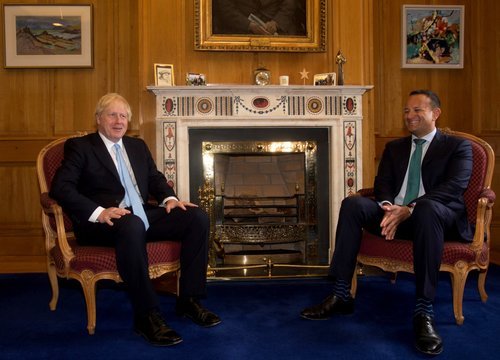British and Irish leaders see ‘pathway to a deal’ after weeks of Brexit deadlock

British and Irish leaders Boris Johnson and Leo Varadkar raised hopes of a breakthrough in the deadlocked Brexit process Thursday, saying they saw a “pathway” to a deal.
After a face-to-face meeting at that was billed as a last chance to map out a deal, the pair issued an unexpectedly upbeat statement that indicated progress could be made.
In a joint statement, both leaders described the two-hour meeting as a “detailed and constructive discussion” where “they agreed that they could see a pathway to a possible deal.”
“Their discussion concentrated on the challenges of customs and consent. They also discussed the potential to strengthen bilateral relations, including on Northern Ireland,” the statement said.
Afterward, Varadkar told journalists he thought it possible for a new deal to be struck by the end of this month.
“I think it is possible for us to come to an agreement, to have a treaty agreed, to allow the UK to leave the EU in an orderly fashion, and have that done by the end of October,” he said. Varadkar added, however, that “there was many a slip between cup and lip” and there could be challenges “that are not in my control.”
“What this is about is securing an agreement that works for the people of Ireland and also of Great Britain and Europe. And a good deal for Ireland means no hard border between the Republic of Ireland and Northern Ireland,” Varadkar said.
The question of the Irish border — and the proposed “backstop” roundly rejected by Brexiteers — has become the most intractable issue in Brexit negotiations.
It is unclear which side conceded ground at the meeting, held at Thornton Manor hotel near Liverpool in northwest England. But the change of tone from Varadkar indicates that Johnson is prepared to make concessions on the plan he put forward earlier this month.
Under that plan, Northern Ireland would leave the EU customs union on the current Brexit deadline of October 31 along with the rest of the UK. But the region would remain aligned with EU regulations on goods and agriculture.
Both sides say they don’t want to place infrastructure on the frontier between Northern Ireland and Ireland, with the absence of a hard border seen as integral to the peace that followed decades of conflict. But Dublin has been skeptical about UK plans to carry out customs checks at facilities set back from the border, and at business premises.
There was also alarm in Dublin over a consent mechanism — a plan to give the Northern Ireland assembly a veto every four years on whether the region should retain EU goods and agriculture regulations.
British officials admit the issue of a consent mechanism for Northern Ireland is a sticking point, but indicate privately there is room for negotiation.
But even if the issue of consent can be resolved, the European Union and United Kingdom have yet to see eye to eye on customs. The return of border posts on the frontier between Northern Ireland and the Republic of Ireland has been a red line for the European Union since Brexit negotiations began.
Hopes are now pinned on a planned meeting Friday between UK Brexit Secretary Stephen Barclay and the European Union’s chief Brexit negotiator Michel Barnier in which both sides could give the go-ahead for a more intense set of negotiations among officials.
They would have little time to conclude a deal before EU leaders are due to meet for a summit on October 17 and 18 — but if significant progress is made in the coming days, it’s possible they may agree to a short extension to the October 31 deadline to get a deal over the line.

